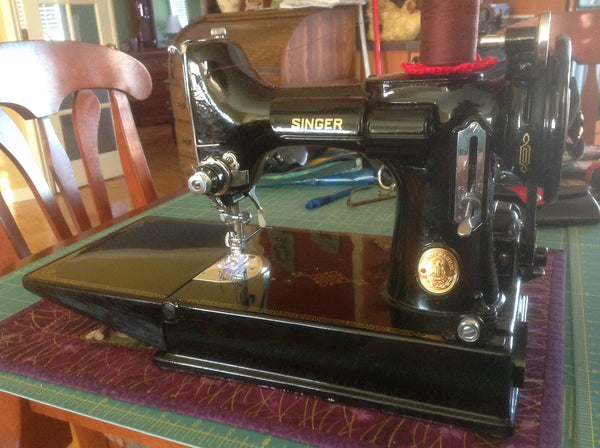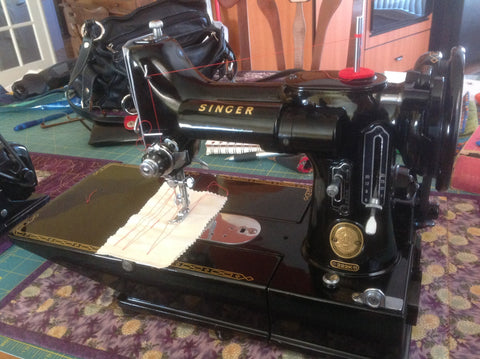Singer Sewing at the St. John's Factory, Quebec, Canada
Today we are featuring a guest article by Lynne McFern of Ste-Catherine, Quebec, Canada. After acquiring a Singer Featherweight and rekindling a link to her past, Lynne was inspired to learn more about the history of her machines. This is her story...
***********************************************
My first sewing experience was on a Singer 66 treadle that had previously been owned by my grandmother. I was very proud of having mastered peddle power until I accidentally sewed through my index finger. That slowed me down a little, but it did not hinder my passion for old sewing machines.
Recently, I bought a 221 Featherweight and the purr of that little baby made me put my expensive modern multi-stitch machine back into its case. It was love at first stitch and my quest did not stop there. I have recently acquired a pristine 222 Featherweight that looks like it was never used.



A few months ago, a 99K was gifted to me and although it is not in working condition, the detailed golden decals on it have earned it a special place in my sewing room. I plan to have this one refurbished eventually.


Recently, I found a Singer 66 treadle! The machine was in bad condition, but I re-purposed the cast iron base and fit a new wooden top for my Featherweights.


As my passion for Singer machines grew, I started researching their history and was surprised to see that all my machines have stickers indicating that they were made in St. John’s, Quebec. As this is a short drive from my home, I decided to go out and explore the birthplace of my Singer babies. Preliminary research indicated that the factory no longer exists, but I wanted to find out more. Last week, I met an Art Gallery owner who was very knowledgeable about the history of the Singer Manufacturing Co. Ltd. The following story may be of interest to Singer parents with inquiring minds.

Construction of The Singer Manufacturing Co. Ltd. in Saint-Jean-sur-Richelieu, Quebec, Canada (St. John’s) began in 1904 and required more than 800 employees and lasted two years. The total cost of construction exceeded $1,000,000, which was an astronomical amount in that era. The choice of this city resulted from a variety of tax advantages granted to Singer, such as exemptions from municipal and school taxes for 20 years, tax credits, construction of a railway for the exclusive use of Singer, $20,000 in funding, donation of the land for the plant as well as its surroundings for residential construction for its employees, etc. In total, more than $500,000 in various grants was offered to the company to help it establish itself in this location.

Official inauguration took place in 1906. The St. Johns plant was 25 times larger than any other plant opened in Canada at that time.
Once completed, the works comprised more than 18 separate fire-proof buildings on 45 acres of ground. It had a floor area of over 12 acres and 5 miles of railway track were laid on the premises. At its peak in the 1950’s and 1960’s, it employed around 3000 people in the foundry, the wood shop, the engineering department and the electrical department, as well as for the assembly line. The factory was so big it had its own firemen and newspaper.

The plant not only produced the cast iron castings for the sewing machines in its foundry, it also had a wood shop where respective cabinets were made. Singer also made a whole line of sewing baskets and sewing accessories.
During the Second World War, the factory was adapted in order to build war materials. Once the war ended, the plant restarted to build sewing machines. The directors of the company took the opportunity to upgrade facilities by building, among others, a new foundry, new warehouses, and two garages. These renovations marked the beginning of the golden age of the plant. Sewing machines manufactured in Saint-Jean-sur-Richelieu were shipped to more than 48 countries.

Although it had been set up with great pomp and prestige, it became a well-known fact that Singer wages were very low when compared to other manufacturers. St. John’s was so desperate to keep jobs for its citizens that no regulations were set for minimum wage rates. In reality, the company created many jobs, but the employees became bitter over time as they compared their wages to others and determined that they were not getting a fair deal by comparison.

Thus, the troubles began. Employees became disgruntled with their working conditions and felt exploited.
The company tried to compensate by creating an employee social club which held annual picnics and Christmas parties and starting a pension plan for its employees. A labor union was set up by the employees but between 1950 and 1980, employee frustration ran so high that the employees went on general strikes on several occasions. Singer’s market share drastically diminished and demand for sewing machines slowly decreased as women joined the workforce.

In desperation, it is reported that Management put the key in the door, closed the plant and disappeared with the employees’ pension funds. The employees were left behind with no jobs and most of St. John’s population fell below the poverty line.

Following this sad demise, it took until 2006 for legal procedures to end and settlements to be paid to the retirees who had been left with nothing. Even more devastating is the fact that most retirees had already passed away by the time the legalities were settled.


The bitterness left behind by this hostile plant closure explains why there are no visible remembrances of the Singer legacy in St. Johns and very few people want to speak openly about it. Bad memories run deeply in this tightly woven community.

The original factory was torn down to build condos. There are a few photos and a few sewing machines set up in the main lobby of the Singer Complex Entrance Hall as a small memento of an era gone by.

Fortunately, there are some of us who still recognize the value of these magnificently engineered sewing machines and who will recognize their advanced qualities and sewing capabilities and who will take the time to refurbish them and cherish them in their private collections. I know I have been conquered!
The site below shows many photos of the abandoned premises [including a few of those included in this article] before they were torn down in 2007 for the construction of condos. The photos give an idea of the size of the premises, but for the sensitive of heart, they are somehow very sad to look at as they show an advanced stage of abandonment with a lot of vandalism to the premises.
(https://www.uer.ca/locations/show.asp?locid=20567)
The unmatched knowledge shared by Singer Sewing in the UK is a very good reference site as they are well-known for their thorough research and information. The machines they describe, although manufactured in the UK, were also manufactured in St. Johns, Quebec, thus explaining the stickers on my 221, 222K, 66 & 99 machines. (http://www.singersewinginfo.co.uk/featherweight/fhome)
This section graciously shared by Singer Sewing in the UK also gives quite a bit of information on the manufacturing plant in St. Johns’ Quebec: (http://www.singersewinginfo.co.uk/stjohns/)
The above text is from internet research and from verbal declarations made to me while on my quest for the history of The Singer Manufacturing Co. Ltd. in St. John’s, Quebec. Various sources are too numerous to enumerate, but I am the author of this article.
Lynne McFern, Ste- Catherine, Quebec


